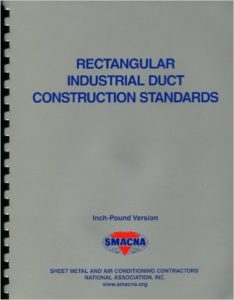Rectangular Industrial Duct Construction Standards
Rectangular Industrial Duct Construction Standards
Rectangular Industrial Duct Construction Standards intended for use by designers of air pollution control and industrial ventilation systems. The standards were developed using sound engineering principles and judgment. The Sheet Metal and Air Conditioning Contractors’ National Association, Inc. does not assume any responsibility or liability for the application of the principles or techniques contained in these standards.
These standards apply to duct fabricated of hot rolled steel, galvanized steel and stainless steel within the recommended temperature limitations for these materials.
You can also Read Indoor Air Quality – A Systems Approach
Rectangular Industrial Duct Construction Standards
1. Definition of Industrial Duct
2. System Classification
3. Types of Material
4. Procedures for Designing Rectangular Duct
5. Design Examples
6. Modifications and Adaptations
7. Tables
A: For Selecting Material Thickness
B: For Selecting Duct Stiffeners (fixed corners)
C: For Selecting Duct Stiffeners (hinged corners)
D: Stiffener/Reinforcing Member Data
E: For Selecting Support Spacing
F: Duct Section Properties
G: Bolting for Flange Connections
H: Hole Gage for Flange Connections
I: Wind conversion
8. Typical seams, connections and stiffeners
9. Design Criteria
Industrial Duct is a broad classification of ductwork used in industry for many diverse applications. It usually associated with an industrial process and will often convey air or gases at high temperature. This air or gas may be corrosive and may contain particulate with varying degrees of abrasiveness. Round duct is usually used in industrial ventilation, air pollution control and dust collecting systems. Despite advantages of the round configuration there are applications for industrial ventilation and air pollution control systems where the rectangular duct must be considered.
The design program on which these standards are based established after exploring design approaches employed by the industry. These standards reflect practical approaches to the very complex design problems associated with rectangular duct construction. The committee hopes that this document will provide a foundation for further work in this field and we invite comments and constructive criticism.

DOES NOT WORK!
Updated